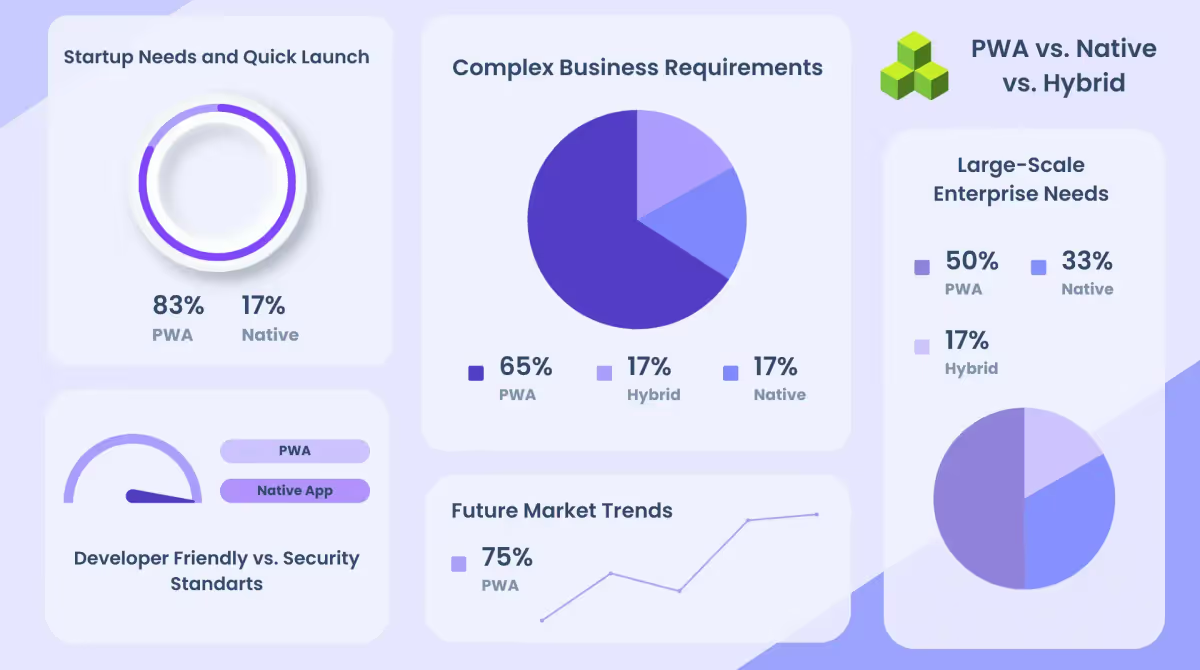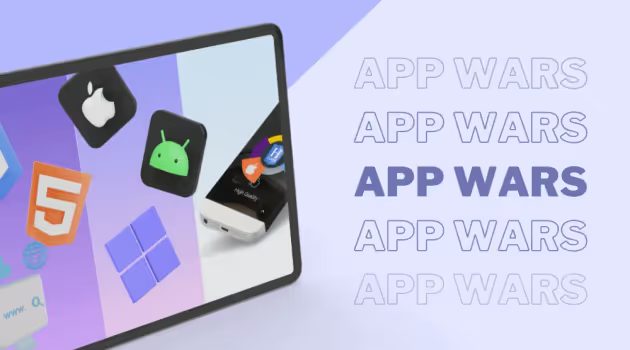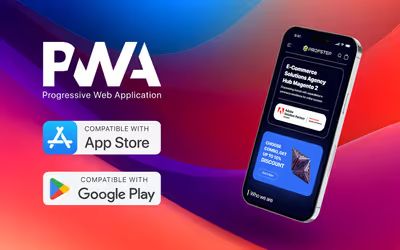When considering online commerce, it's hard to ignore the impact of m-commerce. Nowadays, people use their phones almost constantly, and businesses are striving to keep up with this trend by optimizing their mobile websites for various devices, leveraging innovative technologies, and seeking ways to enhance customer interaction. In 2021, the global number of mobile users reached 7.1 billion, with forecasts indicating that by 2025, this number will increase to 7.49 billion.
Given this trend, it's no surprise that many businesses are opting to implement today's ubiquitous app technologies. Apps have come a long way since 1997. Today, we have quite a few options and opportunities to choose from when it comes to integrating these technologies into our online strategies, aligning them with the company's vision.
Let's take a closer look at three key technologies: Progressive Web Apps (PWAs), native apps, and hybrid apps. We'll explore what they entail, how they differ, and which one to choose to achieve the desired goals.
PWA
In recent years, there has been a noticeable surge in the adoption of Progressive Web Apps (PWAs), a new type of application that combines the functionalities of native apps with the accessibility of websites.
What is a PWA?
PWAs, built solely using web technologies, are versatile and adaptable, operating within browsers and bridging the gap between traditional mobile websites and in-app experiences.
How are PWAs developed?
PWAs are typically developed using commonly used programming languages such as JavaScript, HTML, and CSS, which are the same languages used to create simple responsive websites.
Development Costs
The approximate cost of developing a PWA ranges from $5,000 to $50,000, depending on the specific needs of the company.
Statistics about PWAs
Progressive Web Apps make waves in the digital space. These apps are designed with a 36% higher conversion rate compared to the native apps. Additionally, the average revenue per transaction for such apps goes up by 63%, amounting to a stunning 52% increase over conversions for companies making the shift. In fact, as far as is known, in 2020, more than 68% of leading e-commerce companies had already fully transformed into PWAs.
However, user engagement is the place where they shine. On average, a PWA will push up user engagement by an incredible 180%. It's powered by an incredible 25% re-engagement rate via push notifications from the apps themselves. The next in line is the response to marketing messages, where PWAs have a 146% higher click-through rate.
Furthermore, PWAs also have the advantage of loading in under 2 seconds, making them 2-3 times faster both in contrast with apps and over conventional mobile websites.
Advantages and disadvantages of PWAs
Native Apps
What is a Native App
A native app refers to an application that you can download from the App Store, install on your device, and run independently. It functions as a self-contained program, utilizing various features of your device.
How are Native Apps developed?
Native apps are specifically developed for different platforms such as iOS, Android, and PC.
Commonly used programming languages for mobile app development include Java and Kotlin for Android, Swift for iOS, and JavaScript for cross-platform frameworks like React Native.
Development Costs
In the United States, hiring a developer to create a native app typically costs around $90,000 per year. Development expenses range from $50,000 to $100,000 , with a timeframe of 9 months or longer.
What is the popularity of app stores?
In the United States, Apple's App Store dominates the market for iOS devices, while the Google Play Store is the top choice for Android devices. However, in China, Google Play encounters restrictions, resulting in the preference for alternative Android app stores such as Tencent MyApp, Baidu Mobile Assistant, and Huawei AppGallery. Apple's App Store is also widely adopted for iOS devices in China. Within the European Union, both Apple's App Store and the Google Play Store are extensively used, though local alternatives are available.
Interesting statistics reveal that the Apple App Store offers 1.96 million available apps, while the Google Play Store boasts an mpressive 2.87 million for download.
Advantages and disadvantages of a native mobile app
Hybrid Apps
What is a Hybrid App?
A hybrid app is an application that can be downloaded and installed on multiple mobile platforms, such as Android and iOS. It's designed to utilize the same code across all operating systems, blending elements from both native apps and PWAs. When users download a hybrid app from an app store and install it locally, its native shell connects to their mobile platform's capabilities through an embedded browser in the app.
How are Hybrid Apps developed?
Built with popular front-end development technologies like HTML5, JavaScript, and CSS, hybrid apps offer cross-platform functionality.
Development Costs
Hybrid app development is often considered to be around 30% cheaper than developing separate native applications for Android and iOS. Typically, the cost of hybrid app development ranges from $20,000 to $60,000 or more, depending on the specific requirements of the project.
Who uses Hybrid Apps?
Many popular and widely-used apps around the world utilize hybrid technology. For example, well-known brands such as Gmail, Burger King, Southwest Airlines, eBay, BMW, and Sworkit are all built using hybrid technology.
Advantages and disadvantages of hybrid apps
Comparison
Features
PWA
Native App
Hybrid App
require development
use service workers to cache resources
can store data locally on the device to enable offline access
utilize local storage mechanisms to provide offline functionality
Medium
High
Low
Medium
High
Medium
Limited
With plugins
Good
Best
Good
Best
Good
Good
Limited
Best
Good
Less
Moderate
The most
Medium
High
Medium
Poll
Every business owner should decide which app to use based on their specific requirements, needs, and goals. Each company is unique and has its own vision of engaging with customers and delivering the best experience.
However, here we conducted a short poll among our team to provide insights into common opinions and offer some food for thought or answers to your questions.

PWAs and startups
The most recommended option for startups was Progressive Web Apps. The apparent reasons for the 83.3% of votes cast in favor include cross-platform compatibility, cost-effectiveness, and development speed. PWAs are a tempting option for companies with limited resources who want to launch their product quickly.
Restaurant Industry: Experience and Speed
PWAs are again at the top when it comes to the restaurant business, where appearances are important, ordering should be quick, and payments should be processed without hiccups. The same 83.3% preference indicates that they can provide a web experience that is similar to an app. PWAs are a suitable option for restaurateurs searching for a productive solution.
Industries Driven by Security and Native Apps
All respondents (100%) suggested native applications for high-security areas (e.g., healthcare, finance) where security is critical. The same criteria that applied to the restaurant business also apply to native apps: native apps offer the best features, including security, functionality, and adherence to strict laws. Native is the way to go when it comes to managing sensitive data.
Complexity of the Enterprise: PWAs and Hybrids
Complex business procedures are involved in large organizations. According to our poll, 66.6% of respondents favor PWAs because they value their flexibility and ease of upkeep. Support is also extended to hybrid applications, which provide a compromise between native-like functionality and cross-platform compatibility.
The CBD Sector: A Divided Opinion
There is disagreement about whether or not accessibility and compliance should coexist in the CBD sector. PWAs are preferred by 50% of users due to their scalability and security capabilities, whereas native applications are preferred by 33.3% for managed data management.
Assistance with Travel and PWAs
PWAs are again in the lead for travel agencies, with 66.6% of the vote. Their cross-device compatibility, offline functionality, and real-time updates make them perfect for offering all-encompassing travel support. PWAs provide the information that travelers need to have easily accessible.
Platforms for Watching Videos: Adaptive PWAs
Our team votes for PWAs in the digital video space with 83.3% of the vote. It's the best user experience due to its smooth streaming, personal recommendations, and screen size adjustability. PWAs are the way of the future for online video platforms.
Developer-Friendly Option
Finally, PWAs' utilization of well-known web technologies is shown by the unified 100% vote that supported them as the most developer-friendly choice. The broader applicability of skills and shorter learning curve are valued by developers.
Towards the Future: PWAs Lead
According to 83.3% of our team, PWA will be in the lead during the next five years. They are at the forefront because to their reach, independence from platforms, and user-centric methodology.
Conclusion
When it comes to choosing which app to develop, it's crucial for a company to determine its specific needs, objectives, and intended use for the application. Each of these technologies—Progressive Web Apps (PWAs), Native Apps, and Hybrid Apps—has its own pros and cons, excelling in certain areas while being limited in others.
If you decide that a PWA is the right choice for your business, after reading this blog, we would be delighted to discuss how to turn your vision into reality and help you with this. Please find our contact form below.

